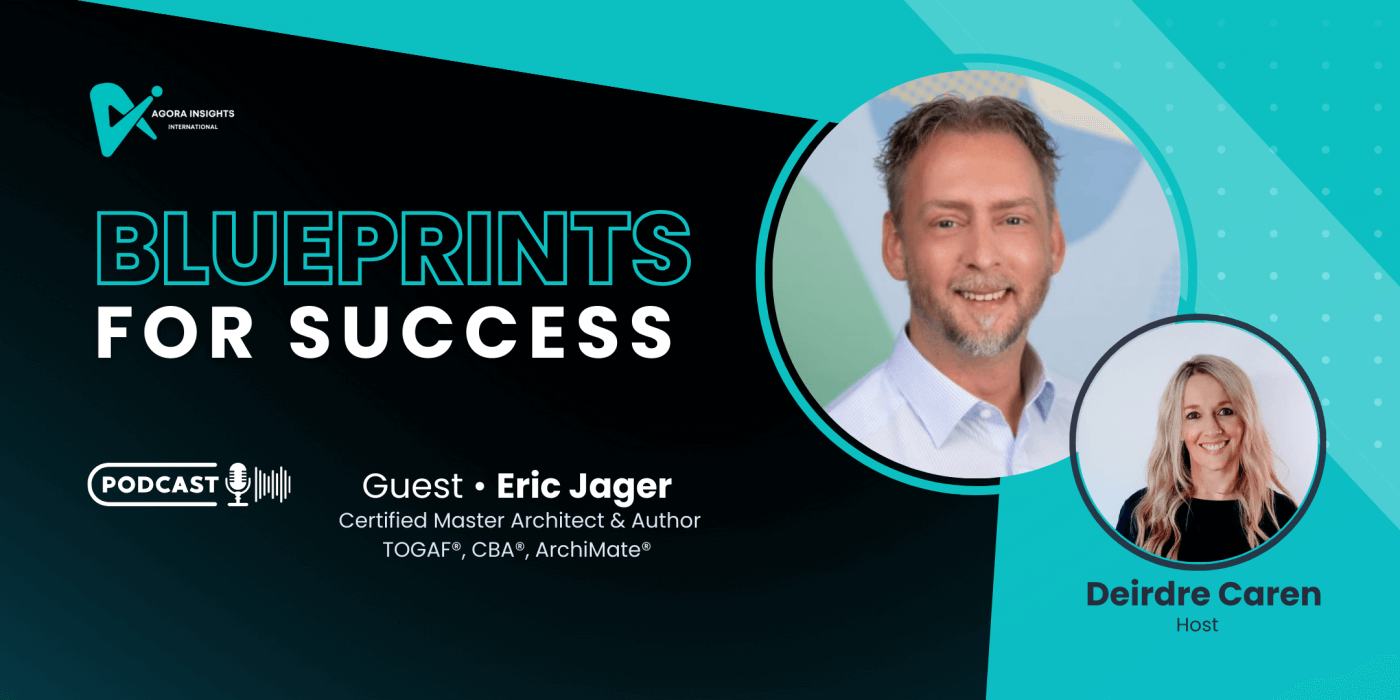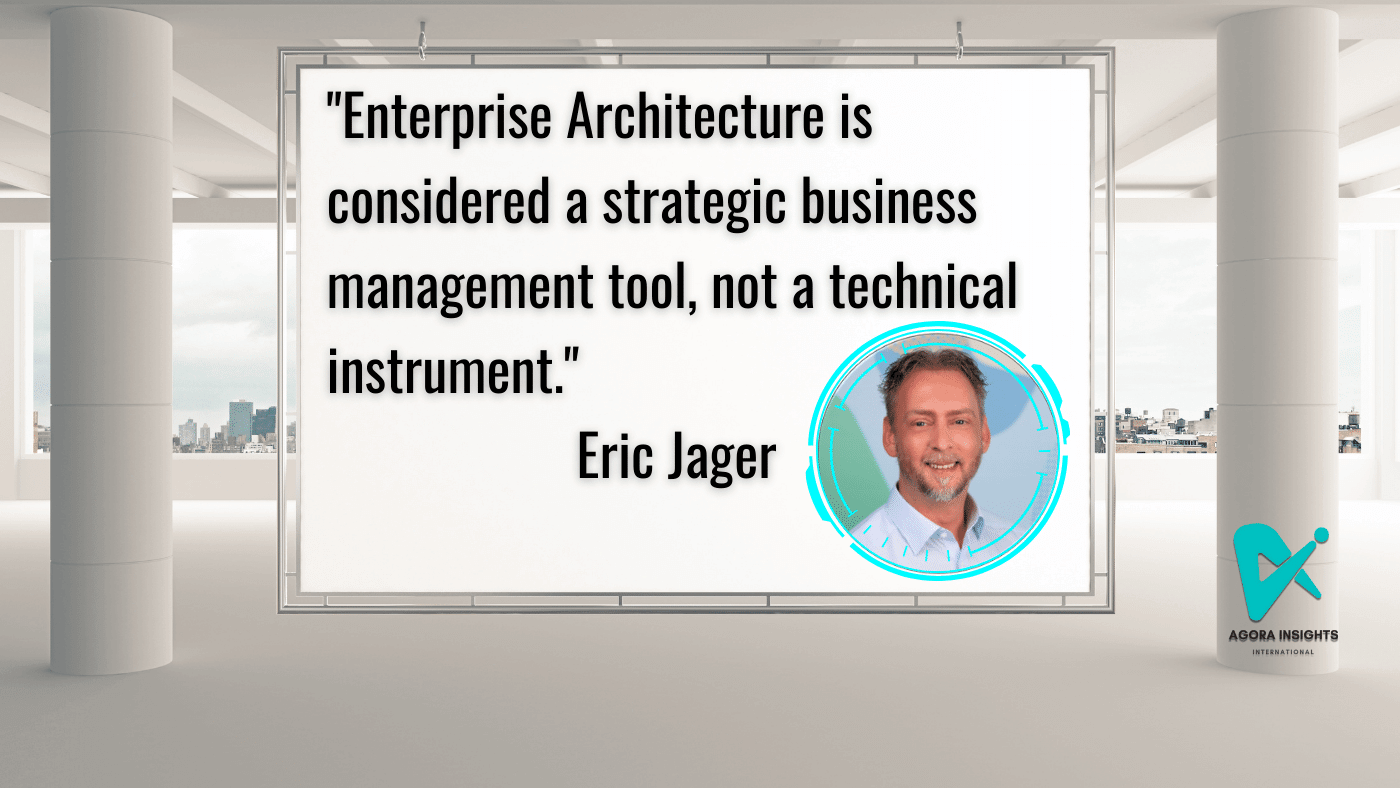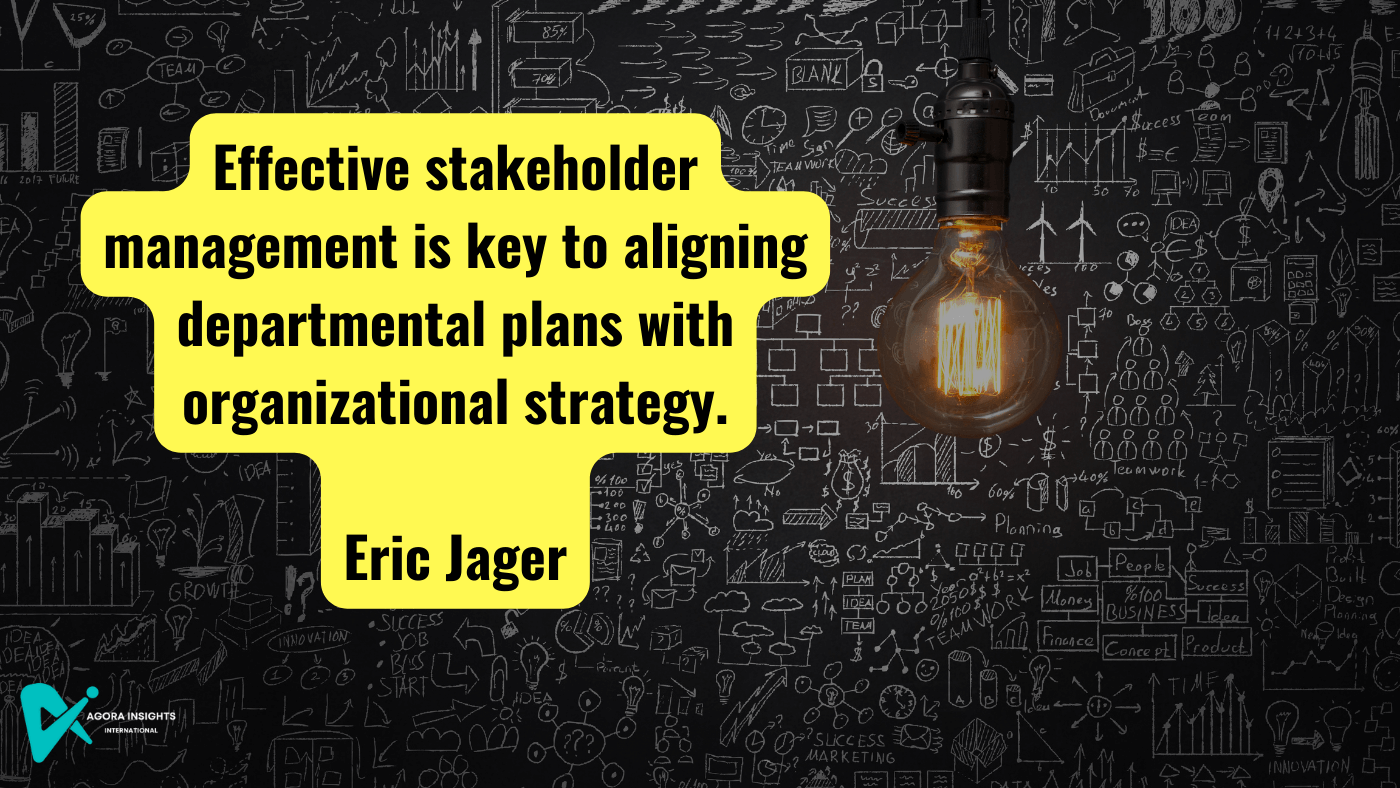
Business and enterprise architecture should directly support the organization's strategy and be positioned as a business-oriented function.
Reflecting on my conversation with Eric Jager, who has carved out a successful career as an enterprise architect (EA) in the Netherlands, it's clear that his insights into architecture provide a new perspective on getting started in the business. Drawing on his book "Getting Started with Enterprise Architecture," Eric provided a wealth of information that can benefit anyone interested in the discipline, whether they are novices or seasoned professionals.

Hosted by Deirdre Caren on Agora Insights' Blueprints for Success
Business and enterprise architecture should directly support the organization's strategy and be positioned as a business-oriented function.
Reflecting on my conversation with Eric Jager, who has carved out a successful career as an enterprise architect (EA) in the Netherlands, it's clear that his insights into architecture provide a new perspective on getting started in the business. Drawing on his book "Getting Started with Enterprise Architecture," Eric provided a wealth of information that can benefit anyone interested in the discipline, whether they are novices or seasoned professionals.

Hosted by Deirdre Caren on Agora Insights' Blueprints for Success
Background
Eric is a Certified Business Architect (CBA) and a Master Architect, a TOGAF Enterprise Architect, an ArchiMate 3 Practitioner as well as an author, blogger, speaker and top voice on Enterprise Architecture on LinkedIn. He has a degree from the University of Amsterdam where he specialized in English.
Eric's journey into this field was a testament to the dynamic nature of the field. He shared anecdotes from his early days, when the discipline was still finding its footing within the IT domain. It was fascinating to hear how he witnessed the shift of enterprise architecture from a predominantly IT-focused role to a strategic lever for business transformation. This evolution underscores the importance of enterprise architecture as a bridge between technology and business strategy, a theme that resonated throughout our discussion.
Three Key Insights
Eric is a Certified Business Architect (CBA) and a Master Architect, a TOGAF Enterprise Architect, an ArchiMate 3 Practitioner as well as an author, blogger, speaker and top voice on Enterprise Architecture on LinkedIn. He has a degree from the University of Amsterdam where he specialized in English.
Eric's journey into this field was a testament to the dynamic nature of the field. He shared anecdotes from his early days, when the discipline was still finding its footing within the IT domain. It was fascinating to hear how he witnessed the shift of enterprise architecture from a predominantly IT-focused role to a strategic lever for business transformation. This evolution underscores the importance of enterprise architecture as a bridge between technology and business strategy, a theme that resonated throughout our discussion.
Three Key Insights
1. Value-Driven Architecture and the EA Wheel
Eric's concept of value-driven architecture resonates with me. The idea is to ensure that every architectural decision is in lockstep with the core values of the organization. This approach is not just about aligning with the company's mission statement; it's about ensuring that every technical or strategic choice has a clear line of sight to the value it brings to the table. The EA Wheel, as Eric described it, is a tool that helps organizations to apply enterprise architecture principles in a way that's tailored to their specific needs and maturity level. It's a more dynamic, less rigid way of thinking about architecture, which I find quite refreshing. It moves away from a one-size-fits-all methodology to something that can be molded to fit the unique contours of any organization.
Eric's concept of value-driven architecture resonates with me. The idea is to ensure that every architectural decision is in lockstep with the core values of the organization. This approach is not just about aligning with the company's mission statement; it's about ensuring that every technical or strategic choice has a clear line of sight to the value it brings to the table. The EA Wheel, as Eric described it, is a tool that helps organizations to apply enterprise architecture principles in a way that's tailored to their specific needs and maturity level. It's a more dynamic, less rigid way of thinking about architecture, which I find quite refreshing. It moves away from a one-size-fits-all methodology to something that can be molded to fit the unique contours of any organization.
2. The Role of Business and EA in Healthcare
It became clear that business and EA are not just about IT. These disciplines are about providing a blueprint for the organization as a whole. They help to bridge the gap between strategy and execution, ensuring that the company moves in unison towards its goals. Eric pointed out the importance of these roles as strategic management tools that help maintain clarity and control over the direction of the enterprise. They're about understanding the ecosystem of the business, both internal and external, and designing structures and processes that support the strategic objectives.
Our discussion then moved to a discussion on the healthcare industry. He shared how architecture within healthcare is uniquely positioned to address some of the sector's most pressing challenges. One of the main issues is the siloed nature of healthcare departments, which often operate independently, leading to inefficiencies and a lack of cohesion. Enterprise and business architecture can play a pivotal role in integrating these disparate parts of an organization. By doing so, architects help ensure that the different departments aren't just aligned with each other but are also strategically aligned with the organization's overarching objectives. This alignment is crucial for delivering better patient care and improving operational efficiency.
It became clear that business and EA are not just about IT. These disciplines are about providing a blueprint for the organization as a whole. They help to bridge the gap between strategy and execution, ensuring that the company moves in unison towards its goals. Eric pointed out the importance of these roles as strategic management tools that help maintain clarity and control over the direction of the enterprise. They're about understanding the ecosystem of the business, both internal and external, and designing structures and processes that support the strategic objectives.
Our discussion then moved to a discussion on the healthcare industry. He shared how architecture within healthcare is uniquely positioned to address some of the sector's most pressing challenges. One of the main issues is the siloed nature of healthcare departments, which often operate independently, leading to inefficiencies and a lack of cohesion. Enterprise and business architecture can play a pivotal role in integrating these disparate parts of an organization. By doing so, architects help ensure that the different departments aren't just aligned with each other but are also strategically aligned with the organization's overarching objectives. This alignment is crucial for delivering better patient care and improving operational efficiency.
3. Starting with Enterprise Architecture
Eric's insights into starting with enterprise architecture were particularly valuable for those new to the field. His book is a guide that demystifies the process of establishing a foundational enterprise architecture. It's about identifying what the organization needs, setting goals that are not just aspirational but measurable, and then communicating those plans effectively within the organization. Eric stressed the importance of clear communication, making sure that everyone from the C-suite to the operational teams understands the role and value of architecture. This clarity from the get-go helps to ensure that enterprise architecture is not seen as just an IT function but as a central part of the business strategy.

Eric's insights into starting with enterprise architecture were particularly valuable for those new to the field. His book is a guide that demystifies the process of establishing a foundational enterprise architecture. It's about identifying what the organization needs, setting goals that are not just aspirational but measurable, and then communicating those plans effectively within the organization. Eric stressed the importance of clear communication, making sure that everyone from the C-suite to the operational teams understands the role and value of architecture. This clarity from the get-go helps to ensure that enterprise architecture is not seen as just an IT function but as a central part of the business strategy.

10 Learning Points
- Value-Driven Focus: Aligning architectural decisions with organizational values is essential for delivering stakeholder value.
- Practical Application: Enterprise architecture should be applied in a way that suits the maturity level of the organization's existing architecture.
- Stakeholder Engagement: Effective stakeholder management is key to aligning departmental plans with organizational strategy.
- Visual Communication: Simplifying complex architecture into visual formats helps stakeholders across the organization understand and engage with it.
- Strategic Alignment: Business and enterprise architecture should directly support the organization's strategy and be positioned as a business-oriented function.
- Continuous Learning: Architects should regularly update their knowledge and skills to stay relevant in the field.
- Listening Skills: Eric stressed that architects must hone their ability to listen and understand the underlying messages from stakeholders.
- Political Acumen: Navigating organizational politics and understanding hidden agendas are critical skills for architects.
- AI and Future Trends: The integration of AI in architecture can support operational efficiency but must be introduced with consideration for user acceptance.
- Starting Point Clarity: Newcomers to the field should seek clarity on the role and impact of architecture from the outset, avoiding being pigeonholed into IT-focused roles.
- Value-Driven Focus: Aligning architectural decisions with organizational values is essential for delivering stakeholder value.
- Practical Application: Enterprise architecture should be applied in a way that suits the maturity level of the organization's existing architecture.
- Stakeholder Engagement: Effective stakeholder management is key to aligning departmental plans with organizational strategy.
- Visual Communication: Simplifying complex architecture into visual formats helps stakeholders across the organization understand and engage with it.
- Strategic Alignment: Business and enterprise architecture should directly support the organization's strategy and be positioned as a business-oriented function.
- Continuous Learning: Architects should regularly update their knowledge and skills to stay relevant in the field.
- Listening Skills: Eric stressed that architects must hone their ability to listen and understand the underlying messages from stakeholders.
- Political Acumen: Navigating organizational politics and understanding hidden agendas are critical skills for architects.
- AI and Future Trends: The integration of AI in architecture can support operational efficiency but must be introduced with consideration for user acceptance.
- Starting Point Clarity: Newcomers to the field should seek clarity on the role and impact of architecture from the outset, avoiding being pigeonholed into IT-focused roles.
Conclusion
In closing, this interview with Eric Jager was incredibly insightful for anyone interested in business and enterprise architecture. His explanations, especially in the healthcare sector, demonstrate the transformative power of architecture when properly aligned with business strategy. For those looking to explore more about Eric's work or connect with him, LinkedIn is the best platform. His book is an excellent resource for those new to the field or looking to refine their approach. Keep an eye on the evolving landscape of architecture, as it's clear that this field will continue to grow and adapt in exciting ways.
I trust that you too have enjoyed this conversation and that it has inspired you to further your learning! Don't forget that Agora Insights truly guides learner to success! Let me know in the comments anything that resonated with you and any questions you have in mind.
 To get weekly videos and interviews from leaders around the world subscribe to our Blueprints for Success Newsletter on LinkedIn
To get weekly videos and interviews from leaders around the world subscribe to our Blueprints for Success Newsletter on LinkedIn
And for anyone who is considering studying soon, take a look at Agora Insights!
In closing, this interview with Eric Jager was incredibly insightful for anyone interested in business and enterprise architecture. His explanations, especially in the healthcare sector, demonstrate the transformative power of architecture when properly aligned with business strategy. For those looking to explore more about Eric's work or connect with him, LinkedIn is the best platform. His book is an excellent resource for those new to the field or looking to refine their approach. Keep an eye on the evolving landscape of architecture, as it's clear that this field will continue to grow and adapt in exciting ways.
I trust that you too have enjoyed this conversation and that it has inspired you to further your learning! Don't forget that Agora Insights truly guides learner to success! Let me know in the comments anything that resonated with you and any questions you have in mind.
 To get weekly videos and interviews from leaders around the world subscribe to our Blueprints for Success Newsletter on LinkedIn
To get weekly videos and interviews from leaders around the world subscribe to our Blueprints for Success Newsletter on LinkedIn
And for anyone who is considering studying soon, take a look at Agora Insights!
Learn more about Eric Jager
Eric Jager is the author of Getting Started with Enterprise Architecture and a Certified Master Architect in the field of EA. He is also a certified TOGAF EA Practitioner, Certified Business Architect and ArchiMate Practitioner. He is familiar with various architecture methodologies including the TOGAF Standard and the Zachman Framework.
Eric has been practicing EA for over 15 years and has extensive knowledge and experience in the development and application of EA. He easily leverages architecture to translate business strategy into implementation.
Based on his years of practical experience, Eric has created a self-designed EA Implementation Wheel: an approach to implementing EA that can be used by both novice and experienced architects. He likes to focus on the practical and pragmatic application of EA. Eric lectures on architecture at the Eindhoven University of Technology and writes about his daily experiences in his blog.
Eric Jager is the author of Getting Started with Enterprise Architecture and a Certified Master Architect in the field of EA. He is also a certified TOGAF EA Practitioner, Certified Business Architect and ArchiMate Practitioner. He is familiar with various architecture methodologies including the TOGAF Standard and the Zachman Framework.
Eric has been practicing EA for over 15 years and has extensive knowledge and experience in the development and application of EA. He easily leverages architecture to translate business strategy into implementation.
Based on his years of practical experience, Eric has created a self-designed EA Implementation Wheel: an approach to implementing EA that can be used by both novice and experienced architects. He likes to focus on the practical and pragmatic application of EA. Eric lectures on architecture at the Eindhoven University of Technology and writes about his daily experiences in his blog.
Eric's Book:
Getting Started with Enterprise Architecture:A Practical and Pragmatic Approach to Learning the Basics of EA 1st ed. Edition
Getting Started with Enterprise Architecture:A Practical and Pragmatic Approach to Learning the Basics of EA 1st ed. Edition

Post a Comment